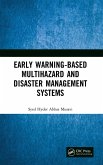Handbook of Emergency Response (eBook, PDF)
A Human Factors and Systems Engineering Approach
Redaktion: Badiru, Adedeji B.; Racz, Leeann
61,95 €
61,95 €
inkl. MwSt.
Sofort per Download lieferbar

31 °P sammeln
61,95 €
Als Download kaufen

61,95 €
inkl. MwSt.
Sofort per Download lieferbar

31 °P sammeln
Jetzt verschenken
Alle Infos zum eBook verschenken
61,95 €
inkl. MwSt.
Sofort per Download lieferbar
Alle Infos zum eBook verschenken

31 °P sammeln
Handbook of Emergency Response (eBook, PDF)
A Human Factors and Systems Engineering Approach
Redaktion: Badiru, Adedeji B.; Racz, Leeann
- Format: PDF
- Merkliste
- Auf die Merkliste
- Bewerten Bewerten
- Teilen
- Produkt teilen
- Produkterinnerung
- Produkterinnerung

Bitte loggen Sie sich zunächst in Ihr Kundenkonto ein oder registrieren Sie sich bei
bücher.de, um das eBook-Abo tolino select nutzen zu können.
Hier können Sie sich einloggen
Hier können Sie sich einloggen
Sie sind bereits eingeloggt. Klicken Sie auf 2. tolino select Abo, um fortzufahren.

Bitte loggen Sie sich zunächst in Ihr Kundenkonto ein oder registrieren Sie sich bei bücher.de, um das eBook-Abo tolino select nutzen zu können.
Despite preemptive preparations, disasters can and do occur. Whether natural disasters, catastrophic accidents, or terrorist attacks, the risk cannot be completely eliminated. A carefully prepared response is your best defense. Handbook of Emergency Response: A Human Factors and Systems Engineering Approach presents practical advice and guidelines
- Geräte: PC
- mit Kopierschutz
- eBook Hilfe
- Größe: 20.92MB
Andere Kunden interessierten sich auch für
![Common Sense Emergency Response (eBook, PDF) Common Sense Emergency Response (eBook, PDF)]() Robert A. BurkeCommon Sense Emergency Response (eBook, PDF)52,95 €
Robert A. BurkeCommon Sense Emergency Response (eBook, PDF)52,95 €![Principles of Emergency Management (eBook, PDF) Principles of Emergency Management (eBook, PDF)]() Principles of Emergency Management (eBook, PDF)113,95 €
Principles of Emergency Management (eBook, PDF)113,95 €![GIS in Hospital and Healthcare Emergency Management (eBook, PDF) GIS in Hospital and Healthcare Emergency Management (eBook, PDF)]() Ric Skinner GispGIS in Hospital and Healthcare Emergency Management (eBook, PDF)142,95 €
Ric Skinner GispGIS in Hospital and Healthcare Emergency Management (eBook, PDF)142,95 €![Grasping the Moment (eBook, PDF) Grasping the Moment (eBook, PDF)]() Christopher BaberGrasping the Moment (eBook, PDF)162,95 €
Christopher BaberGrasping the Moment (eBook, PDF)162,95 €![Counter-Terrorism for Emergency Responders (eBook, PDF) Counter-Terrorism for Emergency Responders (eBook, PDF)]() Robert A. BurkeCounter-Terrorism for Emergency Responders (eBook, PDF)182,95 €
Robert A. BurkeCounter-Terrorism for Emergency Responders (eBook, PDF)182,95 €![Chronicles of Incidents and Response (eBook, PDF) Chronicles of Incidents and Response (eBook, PDF)]() Robert A. BurkeChronicles of Incidents and Response (eBook, PDF)52,95 €
Robert A. BurkeChronicles of Incidents and Response (eBook, PDF)52,95 €![Early Warning-Based Multihazard and Disaster Management Systems (eBook, PDF) Early Warning-Based Multihazard and Disaster Management Systems (eBook, PDF)]() Syed Hyder Abbas MusaviEarly Warning-Based Multihazard and Disaster Management Systems (eBook, PDF)49,95 €
Syed Hyder Abbas MusaviEarly Warning-Based Multihazard and Disaster Management Systems (eBook, PDF)49,95 €-
-
-
Despite preemptive preparations, disasters can and do occur. Whether natural disasters, catastrophic accidents, or terrorist attacks, the risk cannot be completely eliminated. A carefully prepared response is your best defense. Handbook of Emergency Response: A Human Factors and Systems Engineering Approach presents practical advice and guidelines
Dieser Download kann aus rechtlichen Gründen nur mit Rechnungsadresse in A, B, BG, CY, CZ, D, DK, EW, E, FIN, F, GR, HR, H, IRL, I, LT, L, LR, M, NL, PL, P, R, S, SLO, SK ausgeliefert werden.
Produktdetails
- Produktdetails
- Verlag: Taylor & Francis eBooks
- Seitenzahl: 758
- Erscheinungstermin: 22. August 2013
- Englisch
- ISBN-13: 9781466514577
- Artikelnr.: 40066136
- Verlag: Taylor & Francis eBooks
- Seitenzahl: 758
- Erscheinungstermin: 22. August 2013
- Englisch
- ISBN-13: 9781466514577
- Artikelnr.: 40066136
- Herstellerkennzeichnung Die Herstellerinformationen sind derzeit nicht verfügbar.
Badiru, Adedeji B.; Racz, LeeAnn
Introduction Section I: Technical challenges Chapter 1 Robotic technologies
for first response: A review Chapter 2 A practical, simplified chemical
agent sensor placement methodology Chapter 3 Harnessing disruptive
technologies: Quick systems engineering for emergency response Chapter 4 An
emerging framework for unmanned aircraft systems in the national airspace
system: Opportunities and challenges for first responders and emergency
management Chapter 5 Optimization in evacuation route planning Chapter 6
Evacuation planning, analysis, and management Chapter 7 Hierarchical
optimization for helicopter mission for evacuation Chapter 9 Riverflow
prediction for emergency response: Military applications using artificial
neural networks Section II: Human factors issues Chapter 10 Understanding
the influence of the "cry wolf hypothesis" and "false alarm effect" on
public response to emergency warnings Chapter 11 Accessible emergency
management: A human factors engineering approach Chapter 12 Framework for
preparing for the unprepared Chapter 13 Lest we forget: A critical analysis
of bioterrorist incidents, national exercises, and U.S. prevention,
response, and recovery strategies Chapter 14 Resilience to WMD:
Communication and active participation are key Chapter 15 First responders:
A biomechanical evaluation of supply distribution Chapter 16 Dynamics and
dangers of therapeutic strategies for organophosphate poisoning: A
physiologically based model Section III: Managerial models Chapter 17
Coordinated project systems approach to emergency response Chapter 18
Overcoming obstacles to integrated response among incongruent organizations
Chapter 19 Decisions in disaster recovery operations: A game theoretic
perspective on organization cooperation Chapter 20 Integrating Department
of Defense response with nongovernmental organizations during a disaster
Chapter 21 Time is a murderer: The cost of critical path drag in emergency
response Chapter 22 Coordination and control in emergency response Chapter
23 Managing the complexities of incident command Chapter 24 Begin with the
end in mind: An all-hazards systems approach to waste management planning
for homeland security incidents Chapter 25 Creating effective response
communications Chapter 26 Assessing the state of knowledge about emergency
management in other countries Chapter 27 Framework for real-time,
all-hazards global situational awareness Chapter 28 All-hazards response
team preparation: Planning and training concepts Chapter 29 Medical supply
chain resiliency in disasters Chapter 30 Decision support for inland
waterways emergency response
for first response: A review Chapter 2 A practical, simplified chemical
agent sensor placement methodology Chapter 3 Harnessing disruptive
technologies: Quick systems engineering for emergency response Chapter 4 An
emerging framework for unmanned aircraft systems in the national airspace
system: Opportunities and challenges for first responders and emergency
management Chapter 5 Optimization in evacuation route planning Chapter 6
Evacuation planning, analysis, and management Chapter 7 Hierarchical
optimization for helicopter mission for evacuation Chapter 9 Riverflow
prediction for emergency response: Military applications using artificial
neural networks Section II: Human factors issues Chapter 10 Understanding
the influence of the "cry wolf hypothesis" and "false alarm effect" on
public response to emergency warnings Chapter 11 Accessible emergency
management: A human factors engineering approach Chapter 12 Framework for
preparing for the unprepared Chapter 13 Lest we forget: A critical analysis
of bioterrorist incidents, national exercises, and U.S. prevention,
response, and recovery strategies Chapter 14 Resilience to WMD:
Communication and active participation are key Chapter 15 First responders:
A biomechanical evaluation of supply distribution Chapter 16 Dynamics and
dangers of therapeutic strategies for organophosphate poisoning: A
physiologically based model Section III: Managerial models Chapter 17
Coordinated project systems approach to emergency response Chapter 18
Overcoming obstacles to integrated response among incongruent organizations
Chapter 19 Decisions in disaster recovery operations: A game theoretic
perspective on organization cooperation Chapter 20 Integrating Department
of Defense response with nongovernmental organizations during a disaster
Chapter 21 Time is a murderer: The cost of critical path drag in emergency
response Chapter 22 Coordination and control in emergency response Chapter
23 Managing the complexities of incident command Chapter 24 Begin with the
end in mind: An all-hazards systems approach to waste management planning
for homeland security incidents Chapter 25 Creating effective response
communications Chapter 26 Assessing the state of knowledge about emergency
management in other countries Chapter 27 Framework for real-time,
all-hazards global situational awareness Chapter 28 All-hazards response
team preparation: Planning and training concepts Chapter 29 Medical supply
chain resiliency in disasters Chapter 30 Decision support for inland
waterways emergency response
Introduction Section I: Technical challenges Chapter 1 Robotic technologies
for first response: A review Chapter 2 A practical, simplified chemical
agent sensor placement methodology Chapter 3 Harnessing disruptive
technologies: Quick systems engineering for emergency response Chapter 4 An
emerging framework for unmanned aircraft systems in the national airspace
system: Opportunities and challenges for first responders and emergency
management Chapter 5 Optimization in evacuation route planning Chapter 6
Evacuation planning, analysis, and management Chapter 7 Hierarchical
optimization for helicopter mission for evacuation Chapter 9 Riverflow
prediction for emergency response: Military applications using artificial
neural networks Section II: Human factors issues Chapter 10 Understanding
the influence of the "cry wolf hypothesis" and "false alarm effect" on
public response to emergency warnings Chapter 11 Accessible emergency
management: A human factors engineering approach Chapter 12 Framework for
preparing for the unprepared Chapter 13 Lest we forget: A critical analysis
of bioterrorist incidents, national exercises, and U.S. prevention,
response, and recovery strategies Chapter 14 Resilience to WMD:
Communication and active participation are key Chapter 15 First responders:
A biomechanical evaluation of supply distribution Chapter 16 Dynamics and
dangers of therapeutic strategies for organophosphate poisoning: A
physiologically based model Section III: Managerial models Chapter 17
Coordinated project systems approach to emergency response Chapter 18
Overcoming obstacles to integrated response among incongruent organizations
Chapter 19 Decisions in disaster recovery operations: A game theoretic
perspective on organization cooperation Chapter 20 Integrating Department
of Defense response with nongovernmental organizations during a disaster
Chapter 21 Time is a murderer: The cost of critical path drag in emergency
response Chapter 22 Coordination and control in emergency response Chapter
23 Managing the complexities of incident command Chapter 24 Begin with the
end in mind: An all-hazards systems approach to waste management planning
for homeland security incidents Chapter 25 Creating effective response
communications Chapter 26 Assessing the state of knowledge about emergency
management in other countries Chapter 27 Framework for real-time,
all-hazards global situational awareness Chapter 28 All-hazards response
team preparation: Planning and training concepts Chapter 29 Medical supply
chain resiliency in disasters Chapter 30 Decision support for inland
waterways emergency response
for first response: A review Chapter 2 A practical, simplified chemical
agent sensor placement methodology Chapter 3 Harnessing disruptive
technologies: Quick systems engineering for emergency response Chapter 4 An
emerging framework for unmanned aircraft systems in the national airspace
system: Opportunities and challenges for first responders and emergency
management Chapter 5 Optimization in evacuation route planning Chapter 6
Evacuation planning, analysis, and management Chapter 7 Hierarchical
optimization for helicopter mission for evacuation Chapter 9 Riverflow
prediction for emergency response: Military applications using artificial
neural networks Section II: Human factors issues Chapter 10 Understanding
the influence of the "cry wolf hypothesis" and "false alarm effect" on
public response to emergency warnings Chapter 11 Accessible emergency
management: A human factors engineering approach Chapter 12 Framework for
preparing for the unprepared Chapter 13 Lest we forget: A critical analysis
of bioterrorist incidents, national exercises, and U.S. prevention,
response, and recovery strategies Chapter 14 Resilience to WMD:
Communication and active participation are key Chapter 15 First responders:
A biomechanical evaluation of supply distribution Chapter 16 Dynamics and
dangers of therapeutic strategies for organophosphate poisoning: A
physiologically based model Section III: Managerial models Chapter 17
Coordinated project systems approach to emergency response Chapter 18
Overcoming obstacles to integrated response among incongruent organizations
Chapter 19 Decisions in disaster recovery operations: A game theoretic
perspective on organization cooperation Chapter 20 Integrating Department
of Defense response with nongovernmental organizations during a disaster
Chapter 21 Time is a murderer: The cost of critical path drag in emergency
response Chapter 22 Coordination and control in emergency response Chapter
23 Managing the complexities of incident command Chapter 24 Begin with the
end in mind: An all-hazards systems approach to waste management planning
for homeland security incidents Chapter 25 Creating effective response
communications Chapter 26 Assessing the state of knowledge about emergency
management in other countries Chapter 27 Framework for real-time,
all-hazards global situational awareness Chapter 28 All-hazards response
team preparation: Planning and training concepts Chapter 29 Medical supply
chain resiliency in disasters Chapter 30 Decision support for inland
waterways emergency response







